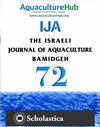米粉和糖蜜混合使用对应用生物絮团技术的凡纳滨对虾生长性能的影响
IF 0.5
4区 农林科学
Q4 FISHERIES
引用次数: 0
摘要
采用3个重复、63 d的完全随机试验,比较了5种不同配比的米粉(R)和糖蜜(M)对凡纳滨对虾(Litopenaeus vannamei Boone, 1931)幼虫后应用生物絮体技术对其生长和存活率的影响。在C/N比例为15:1的条件下,分别添加90% R+10% M、70% R+30% M、50% R+50% M、30% R+70% M、10% R+90% M,形成R90-M10、R70-M30、R50-M50、R30-M70和R10-M90 5个生物群落处理,对照(不施用米粉和糖蜜)随机放入18个体积1.0 m3的塑料池中,每个池加0.5 m3水,盐度为15‰。仔鱼(0.095 g)以150 ind. m - 3的密度投喂颗粒饲料(40%蛋白质)。所有处理的生长(FMW、WG、DWG和SGR)均有改善。此外,糖蜜添加量大于或等于30%的处理提高了SR、FCR和FB。其中,R70-M30的SR最高(94.2%),这可能导致了该处理中最高的FB (1.435 kg m−3)。R70-M30的FCR也最低(1.28),与对照和其他处理有显著差异。试验期间的水质参数均在对虾健康推荐的范围内。结果表明,在不同的米粉和糖蜜配比条件下,以70%的米粉和30%的糖蜜配比为最佳。本文章由计算机程序翻译,如有差异,请以英文原文为准。
Effects of combined rice flour and molasses use on the growth performance of Pacific white shrimp (Litopenaeus vannamei Boone, 1931) applied biofloc technology
A 63-day completely random experiment with three replications was carried out to compare the effects of five different combination ratios of rice flour (R) and molasses (M) on the growth and survival rates of Pacific white shrimp (Litopenaeus vannamei Boone, 1931) postlarvae applied biofloc technology. Five biofloc (BF) treatments, including R90-M10, R70-M30, R50-M50, R30-M70, and R10-M90, formed with the addition of different combination ratios of rice flour and molasses, i.e., 90% R+10% M, 70% R+30% M, 50% R+50% M, 30% R+70% M, and 10% R+90% M, respectively, with C/N ratios of 15:1, and a control (neither rice flour nor molasses applied) was randomly arranged into the 18 plastic tanks of 1.0 m3 volume (with 0.5 m3 of water) each tank and salinity of 15‰. The postlarvae (0.095 g) were stocked into the tanks at a 150 ind. m−3 density and fed pelleted feed (40% protein). There was an improvement in growth (FMW, WG, DWG, and SGR) for all treatments. Besides, treatments with more than or equal to 30% molasses have improved SR, FCR, and FB. Especially the highest SR (94.2%) was obtained at the R70-M30, which perhaps created the highest FB (1.435 kg m−3) in this treatment. The lowest FCR (1.28) was also observed in the R70-M30 and significantly differed from the control and other treatments. Besides, water quality parameters were within the ranges recommended for Pacific white shrimp health during the experimental period. Our findings indicated the benefits of shrimp culture using the BF system when different combined ratios of rice flour and molasses were applied, of which a ratio of 70% rice flour and 30% molasses was considered as the best.
求助全文
通过发布文献求助,成功后即可免费获取论文全文。
去求助
来源期刊
CiteScore
0.90
自引率
16.70%
发文量
49
审稿时长
3 months
期刊介绍:
Information not localized

 求助内容:
求助内容: 应助结果提醒方式:
应助结果提醒方式:


